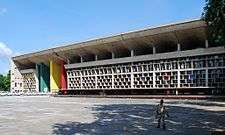Chandigarh
| Chandigarh | ||
|---|---|---|
| City and Union territory† | ||
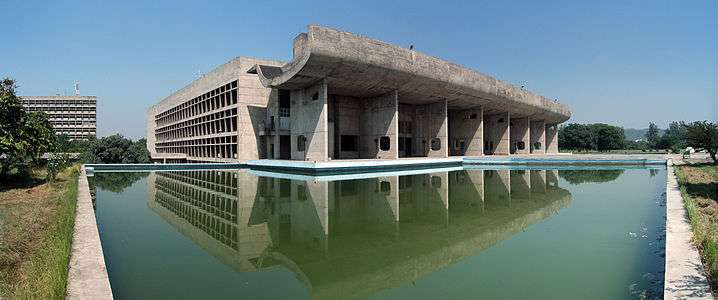 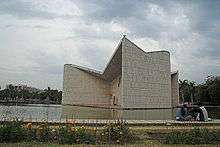   Clockwise from top left: Palace of Assembly, Rock Garden of Chandigarh, Sector 42 Stadium, Sukhna Lake, Open Hand Monument and Gandhi Bhawan | ||
| ||
| Nickname(s): The City Beautiful[lower-alpha 1] | ||
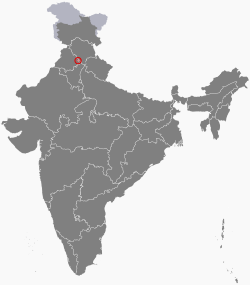 Location of Chandigarh in India | ||
| Coordinates: 30°45′N 76°47′E / 30.75°N 76.78°ECoordinates: 30°45′N 76°47′E / 30.75°N 76.78°E | ||
| Country |
| |
| Formation of Union territory†† | 1 November 1966 | |
| Government | ||
| • Type | Union territory Municipality | |
| • Administrator | V.P. Singh Badnore | |
| • Mayor | Devesh Maudgil | |
| • Senior Deputy Mayor | Sh. Gurpreet Singh | |
| • Deputy Mayor | Vinod Aggarwal | |
| Area | ||
| • Union territory | 114 km2 (44 sq mi) | |
| Area rank | 34th in India | |
| Elevation | 304 m (997 ft) | |
| Population (2011)[1] | ||
| • Union territory | 1,055,450 | |
| • Density | 9,262/km2 (23,988/sq mi) | |
| • Metro[2] | 1,025,682 (51st) | |
| • Urban Area[3] | 1,611,770 | |
| Languages[4] | ||
| • official | English | |
| • education medium[5] | Hindi, Punjabi | |
| Time zone | UTC+5:30 (IST) | |
| PIN | 160XXX | |
| Telephone code | +91-172-XXX-XXXX | |
| ISO 3166 code | IN-CH | |
| Vehicle registration | CH-01 to CH-04 & HR-70 | |
| Literacy | 86.05% | |
| Website |
chandigarh | |
|
†The city of Chandigarh comprises all of the union territory's area. | ||
| Symbols of Chandigarh | ||
| Emblem | Open Hand Emblem | |
| Animal | Indian grey mongoose[6] | |
| Bird | Indian grey hornbill | |
| Flower | Dhak | |
| Fruit | Mango | |
| Tree | Blue Jacaranda | |
Chandigarh (local pronunciation: [tʃə̃ˈɖiːɡəɽʱ] (![]()
Chandigarh is bordered by the state of Punjab to the north, the west and the south, and to the state of Haryana to the east. It is considered to be a part of the Chandigarh capital region or Greater Chandigarh, which includes Chandigarh, and the city of Panchkula (in Haryana) and cities of Kharar, Kurali, Mohali, Zirakpur (in Punjab). It is located 260 km (162 miles) north of New Delhi, 229 km (143 miles) southeast of Amritsar.
It was one of the early planned cities in post-independent India and is internationally known for its architecture and urban design.[7] The master plan of the city was prepared by Swiss-French architect Le Corbusier, which transformed from earlier plans created by the Polish architect Maciej Nowicki and the American planner Albert Mayer. Most of the government buildings and housing in the city, were designed by the Chandigarh Capital Project Team headed by Le Corbusier, Jane Drew and Maxwell Fry. In 2015, an article published by BBC named Chandigarh as one of the perfect cities of the world in terms of architecture, cultural growth and modernisation.[8][9]
Chandigarh’s Capitol Complex was in July 2016 declared by UNESCO as World Heritage at the 40th session of World Heritage Conference held in Istanbul. UNESCO inscription was under "The Architectural Work of Le Corbusier an outstanding contribution to the Modern Movement". The Capitol Complex buildings include the Punjab and Haryana High Court, Punjab and Haryana Secretariat and Punjab and Haryana Assembly along with monuments Open hand, Martyrs Memorial, Geometric Hill and Tower of Shadow.
The city has one of the highest per capita income in the country. The city was reported to be one of the cleanest in India based on a national government study.[10][11] The union territory also heads the list of Indian states and territories according to Human Development Index.[12] In 2015, a survey by LG Electronics, ranked it as the happiest city in India over the happiness index.[13][14] The metropolitan area of Chandigarh–Mohali–Panchkula collectively forms a Tri-city, with a combined population of over 1,611,770.[15]
Etymology
The name Chandigarh is a compound of Chandi and Garh. Chandi refers to Hindu goddess Chandi and Garh means fortress.[16] The name is derived from Chandi Mandir, an ancient temple devoted to the Hindu Goddess Chandi, near the city in Panchkula District.[17]
The motif or sobriquet of "The City Beautiful" was derived from the City Beautiful movement that was a popular philosophy in North American urban planning during the 1890s and 1900s. Architect Albert Mayer, the initial planner of Chandigarh, lamented the American rejection of City Beautiful concepts and declared "We want to create a beautiful city..."[18] The phrase was used on as a logo in official publications in the 1970s, and is now how the city describes itself.[19][20]
History
Early history
The city has a prehistoric past. Due to the presence of a lake, the area has fossil remains with imprints of a large variety of aquatic plants and animals, and amphibian life, which were supported by that environment. As it was a part of the Punjab region, it had many rivers nearby where the ancient and primitive settling of humans began. So, about 8000 years ago, the area was also known to be a home to the Harappans.[21]
Modern history
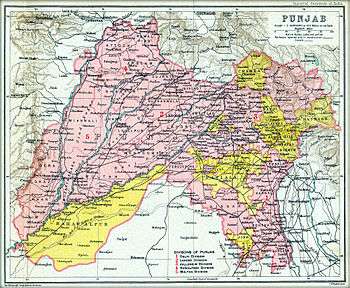
Chandigarh was the dream city of India's first Prime Minister, Jawaharlal Nehru. After the partition of India in 1947, the former British province of Punjab was split between (mostly Sikhs) East Punjab in India and (mostly Muslim) West Punjab in Pakistan.[22] The Indian Punjab required a new capital city to replace Lahore, which became part of Pakistan during the partition.[23][24] Therefore, an American planner and architect Albert Mayer was tasked to design a new city called "Chandigarh" in 1949. The government carved out Chandigarh of nearly 50 Pwadhi speaking villages of the then state of East Punjab, India.[25] Shimla was the temporary capital of East Punjab until Chandigarh was completed in 1960.
Albert Mayer, during his work on the development and planning of the new capital city of Chandigarh, developed a superblock-based city threaded with green spaces which emphasized cellular neighborhoods and traffic segregation. His site plan used natural characteristics, using its gentle grade to promote drainage and rivers to orient the plan. Mayer discontinued his work on Chandigarh after developing a master plan for the city when his architect-partner Matthew Nowicki died in a plane crash in 1950. Government officials recruited Le Corbusier to succeed Mayer and Nowicki, who enlisted many elements of Mayer's original plan without attributing them to him.[26]
Le Corbusier designed many administration buildings, including the High Court, the Palace of Assembly and the Secretariat Building. Le Corbusier also designed the general layout of the city, dividing it into sectors. Chandigarh hosts the largest of Le Corbusier's many Open Hand sculptures, standing 26 metres high. The Open Hand (La Main Ouverte) is a recurring motif in Le Corbusier's architecture, a sign for him of "peace and reconciliation. It is open to give and open to receive." It represents what Le Corbusier called the "Second Machine Age".[27] Two of the six monuments planned in the Capitol Complex which has the High Court, the Assembly and the Secretariat, remain incomplete. These include Geometric Hill and Martyrs Memorial; drawings were made, and they were begun in 1956, but they were never completed.[28]
On 1 November 1966, the newly formed state of Haryana was carved out of the eastern portion of East Punjab, in order to create a new state for the majority Haryanvi-speaking people in that portion, while the western portion of East Punjab retained a mostly Punjabi-speaking majority and was renamed as Punjab. Chandigarh was located on the border of both states and the states moved to incorporate the city into their respective territories. However, the city of Chandigarh was declared a union territory to serve as capital of both states.[29]
As of 2016, many historical villages in Chandigarh are still inhabited within the modern blocks of sectors including Burail and Attawa, while there are a number of non-sectoral villages that lie on the outskirts of the city. These villages were a part of the pre-Chandigarh era.[30]
Geography and ecology

Location
Chandigarh is located near the foothills of the Sivalik range of the Himalayas in northwest India. It covers an area of approximately 114 km2.[24] It borders the states of Haryana and Punjab. The exact cartographic co-ordinates of Chandigarh are 30°44′N 76°47′E / 30.74°N 76.79°E.[31] It has an average elevation of 321 metres (1053 ft).
The city, lying in the northern plains, includes a vast area of flat, fertile land. Its northeast covers sections of Bhabar and while the remainder of its terrain is part of the Terai.[32] The surrounding cities are Mohali, Patiala, Zirakpur and Roopnagar in Punjab, and Panchkula and Ambala in Haryana.
Chandigarh is situated114(28 miles) northeast of Ambala, 229 km (143 miles) southeast of Amritsar and 250 km (156 miles) north of Delhi.
Climate
Chandigarh has a humid subtropical climate (Köppen: Cwa) characterised by a seasonal rhythm: very hot summers, mild winters, unreliable rainfall and great variation in temperature (−1 °C to 46 °C OR 30.2 °F to 114 °F). The average annual rainfall is 1110.7 mm. The city also receives occasional winter rains from the Western Disturbance originating over the Mediterranean Sea.
The western disturbances usually bring rain predominantly from mid-December till end of April which can be heavier sometimes with strong winds and hails if the weather turns colder (during March–April months) which usually proves disastrous to the crops. Cold winds usually tend to come from the north near Shimla, capital of Himachal Pradesh and from the state of Jammu and Kashmir, both of which receive their share of snowfall during wintertime.
The city experiences the following seasons and the respective average temperatures:
- Spring: The climate remains the most enjoyable part of the year during the spring season (from February-end to early-April). Temperatures vary between (max) 13 °C to 20 °C and (min) 5 °C to 12 °C.
- Autumn: In autumn (from September-end to mid November.), the temperature may rise to a maximum of 30 °C. Temperatures usually remain between 10° to 22° in autumn. The minimum temperature is around 6 °C.
- Summer: The temperature in summer (from Mid-April to June-end) may rise to 44 °C. The temperatures might sometime rise to 44 °C in mid-June. Temperatures generally vary between 40 and 42 °C.
- Monsoon: During monsoon (from early-July to mid-September), Chandigarh receives moderate to heavy rainfall and sometimes heavy to very heavy rainfall (generally during the month of August or September). Usually, the rain bearing monsoon winds blow from south-west/south-east. Mostly, the city receives heavy rain from south (which is mainly a persistent rain) but it generally receives most of its rain during monsoon either from North-west or North-east. The maximum amount of rain received by the city of Chandigarh during monsoon season is 195.5 mm in a single day.
- Winter: Winters (November-end to February-end) are mild but they can sometimes get quite chilly in Chandigarh. Average temperatures in the winter remain at (max) 5 °C to 14 °C and (min) -1 °C to 5 °C. Rain usually comes from the west during winters and it is usually a persistent rain for 2–3 days with sometimes hailstorms. The city witnessed bone-numbing chill as the maximum temperature on Monday, 7 January 2013 plunged to a 30-year low to settle at 6.1 degrees Celsius.
| Climate data for Chandigarh | |||||||||||||
|---|---|---|---|---|---|---|---|---|---|---|---|---|---|
| Month | Jan | Feb | Mar | Apr | May | Jun | Jul | Aug | Sep | Oct | Nov | Dec | Year |
| Record high °C (°F) | 27.7 (81.9) |
32.8 (91) |
37.8 (100) |
42.7 (108.9) |
44.6 (112.3) |
45.3 (113.5) |
42.0 (107.6) |
39.0 (102.2) |
37.5 (99.5) |
37.0 (98.6) |
34.0 (93.2) |
28.5 (83.3) |
45.6 (114.1) |
| Average high °C (°F) | 20.4 (68.7) |
23.1 (73.6) |
28.4 (83.1) |
34.5 (94.1) |
38.3 (100.9) |
38.6 (101.5) |
34.0 (93.2) |
32.7 (90.9) |
33.1 (91.6) |
31.8 (89.2) |
27.3 (81.1) |
22.1 (71.8) |
30.4 (86.7) |
| Average low °C (°F) | 6.1 (43) |
8.3 (46.9) |
13.4 (56.1) |
18.9 (66) |
23.1 (73.6) |
25.4 (77.7) |
23.9 (75) |
23.3 (73.9) |
21.8 (71.2) |
17.0 (62.6) |
10.5 (50.9) |
6.7 (44.1) |
16.5 (61.7) |
| Record low °C (°F) | 0.0 (32) |
0.0 (32) |
4.2 (39.6) |
7.8 (46) |
13.4 (56.1) |
14.8 (58.6) |
14.2 (57.6) |
17.2 (63) |
14.3 (57.7) |
9.4 (48.9) |
3.7 (38.7) |
0.0 (32) |
0.0 (32) |
| Average rainfall mm (inches) | 33.1 (1.303) |
38.9 (1.531) |
30.4 (1.197) |
8.5 (0.335) |
28.4 (1.118) |
145.2 (5.717) |
280.4 (11.039) |
307.5 (12.106) |
133.0 (5.236) |
21.9 (0.862) |
9.4 (0.37) |
21.9 (0.862) |
1,059.3 (41.705) |
| Average rainy days | 2.6 | 2.8 | 2.6 | 1.1 | 2.1 | 6.3 | 12.3 | 11.4 | 5.0 | 1.4 | 0.8 | 1.4 | 49.8 |
| Source: India Meteorological Department (record high and low up to 2010)[33][34] | |||||||||||||
Ecosystem

Most of Chandigarh is covered by dense banyan and eucalyptus plantations. Ashoka, cassia, mulberry and other trees flourish in the forested ecosystem. The city has forests surrounding that sustain many animal and plant species.[35] Deer, sambars, barking deer, parrots, woodpeckers and peacocks inhabit the protected forests. Sukhna Lake hosts a variety of ducks and geese, and attracts migratory birds from parts of Siberia and Japan in the winter season.
The Parrot Bird Sanctuary Chandigarh situated in sector 21 of the city provides home to a large number of parrots. Sukhna Wildlife Sanctuary was declared a wildlife sanctuary in 1998.
Landscape
Sukhna Lake, a 3 km artificial rain-fed lake in Sector 1,[36] was created in 1958 by damming the Sukhna Choe, a seasonal stream coming down from the Shivalik Hills.[37]
Chandigarh has a belt of parks running from sector to sector. It is known for its green belts and other special tourist parks.[38] Sukhna Lake itself hosts the Garden of Silence.[39] The Rock Garden, also known as Nek Chand Rock Garden after its founder,[40][41] is located near the Sukhna Lake and has numerous sculptures made by using a variety of different discarded waste materials like frames, mudguards, forks, handle bars, metal wires, play marbles, porcelain, auto parts, broken bangles etc.[42] The 30-40 acre Zakir Hussain Rose Garden contains nearly 825 varieties of roses in it and more than 32,500 varieties of other medicinal plants and trees.[43] Other gardens include the Garden of Fragrance in Sector 36, Garden of Palms in Sector 42, Butterfly Park in Sector 26, Valley of Animals in Sector 49, the Japanese Garden in Sector 31 and the Terraced Garden in Sector 33. Shanti Kunj Garden located between rose garden and cricket stadium in Sector 16 is another garden full of flora and fauna.This garden contains plenty of medicinal plants which are used to cure many diseases.[44] the Botanical Garden and the Bougainvillea Garden,.[45]. There is also a Government museum and art gallery in sector 10-C having collections of sculptures and miniature paintings.
Demographics
Population
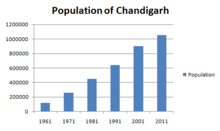
As of 2011 India census, Chandigarh had a population of 1,055,450,[1] making for a density of about 9,252 (7,900 in 2001) persons per square kilometre.[46][47]
Males constitute 55% of the population and females 45%. The sex ratio is 818 females for every 1,000 males[3] –which is the third lowest in the country,[48][lower-alpha 2] up from 773 in 2001. The child sex ratio is 880 females per thousand males, up from 819 in 2001.[49] Chandigarh has an average literacy rate of 86.77%, higher than the national average; with male literacy of 90.81% and female literacy of 81.88%.[3] 10.8% of the population is under 6 years of age.[3]
There has been a substantial decline in the population growth rate in Chandigarh, with just 17.10% growth between 2001-2011. Since, 1951-1961 the rate has decreased from 394.13% to 17.10%. This is probably because of rapid urbanisation and development in neighbouring cities.[50] The urban population constitutes of as high as 97.25% of the total and the rural population makes up 2.75% as there are only few villages within Chandigarh on its Western and South-Eastern border and majority of people live in the heart of Chandigarh.[49]
Languages
Languages of Chandigarh (2011)[4]
English is the sole official language of Chandigarh. The majority of the population speaks Hindi (73%) while Punjabi is spoken by 23%.[51][4] Government schools use English, Hindi and Punjabi textbooks.[5]
Religion
Hinduism is the prominent religion of Chandigarh followed by 80.78% of the population. Sikhism is the second most popular religion in the city followed by 13.11% of the people. In Chandigarh city Islam is followed by 4.87%. Minorities are Christians 0.83%, Jains 0.19%, Buddhists 0.11%, those that didn't state a religion are 0.10%, and others are 0.02%.[53]
Many institutions serve the minorities in the city. One such being the Roman Catholic Diocese of Simla and Chandigarh, serving the Catholics, which even has a co-cathedral in the city, Christ the King Co-Cathedral, although it never was a separate bishopric. Most of the convent schools of Chandigarh are governed by this institution.
Chandigarh hosts many religious places, including Chandimandir, the temple after which it was named. The ISKCON temple in Sector 36 is one among the worship places for Hindus. Nada Sahib Gurudwara, a famous place for Sikh worship lies in its vicinity.[54] Apart from this, there are a couple of historical mosques in Manimajra and Burail.[55]
Economy
Chandigarh has been rated as one of the "Wealthiest Towns" of India.[56] The Reserve Bank of India ranked Chandigarh as the Third largest deposit centre and seventh largest credit centre nationwide as of June 2012. With a per capita income of ₹99,262, Chandigarh is one of the richest cities in India.[57] Chandigarh's gross state domestic product for 2014-15 is estimated at ₹0.29 lakh crore (US$4.3 billion) in current prices. According to a 2014 survey, Chandigarh is ranked 4th in the top 50 cities identified globally as "emerging outsourcing and IT services destinations" ahead of cities like Beijing.[58]
Employment
The government is a major employer in Chandigarh with three governments having their base here i.e. Chandigarh Administration, Punjab government and Haryana government. A significant percentage of Chandigarh’s population therefore consists of people who are either working for one of these governments or have retired from government service mainly Armed forces. For this reason, Chandigarh is often called a "Pensioner's Paradise".[59] Ordnance Cable Factory of the Ordnance Factories Board has been set up by the Government of India. There are about 15 medium to large industries including two in the Public sector. In addition Chandigarh has over 2500 units registered under small-scale sector. The important industries are paper manufacturing, basic metals and alloys and machinery. Other industries are relating to food products, sanitary ware, auto parts, machine tools, pharmaceuticals and electrical appliances.
The main occupation here is trade and business.[60][61] However, the Punjab and Haryana High Court, Post Graduate Institute of Medical Education and Research (PGIMER), the availability of an IT Park and more than a hundred of government schools provide job opportunity to people.
Four major trade promotion organisations have their offices in Chandigarh. These are: The Associated Chambers of Commerce & Industry, ASSOCHAM India [62] in Sector 8, Chandigarh, Federation of Indian Chambers of Commerce & Industry, (FICCI) the PHD Chamber of Commerce and Industry (PHDCCI) and the Confederation of Indian Industry (CII) which has its regional headquarters at Sector 31, Chandigarh.[63][64]
Chandigarh IT Park (also known as Rajiv Gandhi Chandigarh Technology Park) is the city's attempt to break into the information technology world. Chandigarh's infrastructure, proximity to Delhi, Haryana, Punjab and Himachal Pradesh, and the IT talent pool attracts IT businesses looking for office space in the area. Major Indian firms and multinational corporations like Quark, Infosys, EVRY, Dell, IBM, TechMahindra, Airtel, Amadeus IT Group, DLF have set up base in the city and its suburbs.
The work of the Chandigarh Metro is likely to start by the year 2019. It was initially opposed by the Member of parliament from Chandigarh, Kirron Kher.[65] with estimated cost of around ₹10,900 crores including 50% funds from the governments of Punjab and Haryana and 25% from Chandigarh and Government of India. Funds from the Japanese government will include approximately 56% of the cost.[66][67] Kher promised a film city for Chandigarh. After winning the seat, she said that she had difficulty in acquiring land in Chandigarh.[68] However, her proposal was accepted by the Chandigarh Administration and the film city is proposed to be set up in Sarangpur, Chandigarh.[69] These are seen as media of creating jobs.
Politics

Chandigarh, as a Union Territory, is not entitled to a state-level election: thus State Assembly elections are not held and it is directly controlled by the central government. However, one seat is contested here for the General Elections held every five years.
The following Members of Parliament have been elected till date from the Chandigarh constituency:
The city is controlled by a civic administration. In the Municipal Corporation, BJP candidate Arun Sood defeated Congress' Mukesh Bassi by 21-15 votes for the post of Mayor, while BJP's Davesh Moudgil and SAD's Hardeep Singh defeated Congress' Darshan Garg and Gurbax Rawat for the posts of Sr. Deputy Mayor and Deputy Mayor respectively, in the Municipal Corporation's mayoral polls in January 2016.[70] In January 2017 BJP's Asha Kumari Jaswal was elected as the mayor, BJP's Rajesh Kumar Gupta and Anil Dubey were elected as senior deputy mayor and deputy mayor respectively.[71]
Composition of Chandigarh Municipal Corporation as of February 2017[71][72]
| Political Party | Number of Councillers | |
|---|---|---|
| Bharatiya Janata Party | 20 | |
| Shiromani Akali Dal | 1 | |
| Indian National Congress | 4 | |
| Independent | 1 | |
| Nominated | 9 | |
| Member of Parliament | 1 | |
| Total | 36 | |
Education

There are numerous educational institutions in Chandigarh. These range from privately and publicly operated schools to colleges and the Panjab University. Other Institutions are Post Graduate Institute of Medical Education and Research (PGIMER), Govt Medical college & Hospital, Punjab Engineering College Deemed University, Govt College for Men, Govt College for Women, DAV College, MCM DAV College for Women, Goswami Ganesh Dutta Sanatan Dharma College Sector-32, Govt Homeopathic College, Ayurvedic College, Govt Polytechnical College, Govt Home Science College, Dr Ambedkar Institute of Hotel management, Khalsa College Sec- 26, National Institute of Technical Teachers Training and Research(NITTTR) Sec-26, Government College of Commerce and Business Administration (GCCBA) Sec-50 etc.
According to Chandigarh administration's department of education, there are a total of 115 government schools in Chandigarh, including Government Model Senior Secondary School, Sector 16 and convent schools like St. Stephen's School, St. John's High School, Chandigarh, St. Anne's Convent School, Sacred Heart Senior Secondary School, St. Kabir Public School, St. Xavier’s Senior Secondary School and Carmel Convent School.
Transport
Road
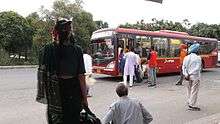
Chandigarh has the largest number of vehicles per capita in India.[73] Wide, well maintained roads and parking spaces all over the city ease local transport.[74] The Chandigarh Transport Undertaking (CTU) operates public transport buses from its Inter State Bus Terminals (ISBT) in Sectors 17 and 43 of the city.[75] CTU also operates frequent bus services to the neighbouring states of Punjab, Haryana, Himachal Pradesh and to Delhi.
Chandigarh is well connected by road to the following nearby cities, by the following highway routes:
Air
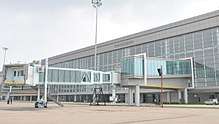
Chandigarh Airport has scheduled commercial flights to major cities of India including Delhi, Mumbai, Kolkata, Hyderabad, Bangalore, Pune, Chennai, Leh , Srinagar, Jaipur, Lucknow, Ahmedabad and Indore. The airport has international flights to Bangkok, Dubai and Sharjah.
Rail

Chandigarh Junction railway station lies in the Northern Railway zone of the Indian Railway network and provides connectivity to most of the regions of India. It provides connectivity to eastern states with link to cities like Kolkata, Dibrugarh; southern states with trains to Visakhapatnam, Thiruvananthapuram, Bangalore, Chennai, Madurai and Kollam; western states with trains to Jaipur, Ahmedabad, Mumbai and Pune; central states with trains to Bhopal and Indore; other northern states with trains to Lucknow, Amritsar, Ludhiana, Ambala, Panipat and Kalka.
Culture
Festivals
Every year, in September or October during the festival of Navratri, many associations and organisations hold a Ramlila event which has been conducted for over 50 years.[76]
The "Rose Festival" in Zakir Hussain Rose Garden in February every year, shows thousands of subspecies of roses.[77]
The Mango Festival, held during the monsoons, and other festivals are held at Sukhna Lake.Christmas,Easter and Good Friday are the other major festivals in the City.
Sports
The Sector 16 Stadium, has been a venue of several international cricket matches. But it has lost prominence after the PCA Stadium was constructed in Mohali. It still provides a platform for cricketers in this region to practice and play inter-state matches.[78]
The Chandigarh Golf Club has 7,202 yard, 18 hole course known for its challenging narrow fairways, a long 613 yard long, dogleg 7th hole and floodlighting on the first nine holes.[79]
There are many other sports grounds and complex like the Lake Sports Complex; Sports Complexes in Sectors 7, 42, 46; Table Tennis Hall, Sector 23; Hockey Centre, Sector 18; Football Stadium, Sector 17; Skating Rink, Sector 10; Wrestling, Basketball and Handball Indoor Hall, Sector 42; CLTA Lawn Tennis Grounds, Sector 10; Athletics Stadium, Sector 7 and 26 Police Lines; Volleyball Courts, Sector 7 and so on. Many personalities from this region have excelled in sports.[80]
Notable people from Chandigarh
- Mohinder Singh Randhawa, Indian Civil Service officer who played a major role in establishing the city of Chandigarh
- Neerja Bhanot, Ashoka Chakra Awardee, flight attendant and model
- Milkha Singh Commonwealth gold medalist.[81][82]
- Kapil Dev, former Indian international cricketer[83]
- Jaspal Bhatti, Padma Bhushan Awardee, Film and TV Actor and renowned satirist
- Kirron Kher, Indian actress and theatre artist (also BJP M.P. from the city)[84]
- Sargun Mehta, Punjabi Film Actress
- Prince Narula, Actor
- Yuvraj Singh, Indian international cricketer[85]
- Gurleen Chopra, Punjabi actress[86]
- Jeev Milkha Singh, professional Golfer[87]
- Binny Bansal, Founder of Flipkart, Billionaire.[88]
- Sachin Bansal, Founder of Flipkart, Billionaire.[88][89]
- Mohit Sehgal, TV actor
- Kulraj Randhawa, Punjabi Film Actress[90]
- Ayushman Khurrana, Indian Film actor
- Gurbani Judge, MTV India VJ and actress
- Harita Kaur Deol, Pilot
- Mamta Joshi, Sufi singer
- Yami Gautam, Indian film actress
- Surveen Chawla, Punjabi Film Actress
- Gul Panag, Indian film actress and Social Activist[91]
- Abhinav Bindra, Olympic gold medalist[92]
- Mahi Gill, Indian actress[93]
- Mukesh Gautam, Punjabi film director
- Gajendra Pal Singh Raghava, Bioinformatics Scientist[94]
- Ramesh Kumar Nibhoria, winner of Ashden Awards-UK[95]
- Nek Chand, Indian artist and creator of the Rock Garden of Chandigarh[96]
- Sabeer Bhatia, Indian-American Entrepreneur who founded Hotmail[97]
- Rochak Kohli, Music Composer, Singer, Lyricist
- Sandesh Jhingan, Indian International Professional footballer
- Neel Kamal Puri Novelist, Columnist
- Aanchal Kumar Model, Actress
- Sri Srinivasan, United States Circuit Judge of the United States Court of Appeals for the District of Columbia Circuit
- Pammi Somal, Bollywood journalist and filmmaker
- Sarbjit Bahga, Architect, Author, Photo-artist
- Piare Lal Sharma, writer
Gallery
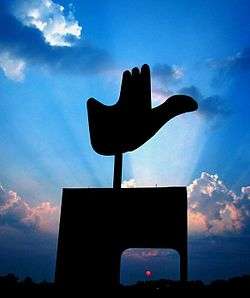 The Open Hand Monument in Chandigarh
The Open Hand Monument in Chandigarh- Punjab and Haryana High Court
 Secretariat Building by Le Corbusier
Secretariat Building by Le Corbusier Palace of Assembly Building by Le Corbusier
Palace of Assembly Building by Le Corbusier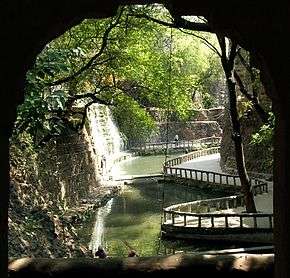 Rock Garden
Rock Garden- The Rose Garden
- Government Museum & Art Gallery
 Musical Fountain, Sector 17, Chandigarh
Musical Fountain, Sector 17, Chandigarh Le Corbusier Centre, Sector 19
Le Corbusier Centre, Sector 19 The entrance to Valley of Animals, Sector 49 in Chandigarh.
The entrance to Valley of Animals, Sector 49 in Chandigarh. Chandigarh Museum and Art Gallery
Chandigarh Museum and Art Gallery Capitol Complex - Tower of Shadow
Capitol Complex - Tower of Shadow Capitol Complex - Legislative Assembly
Capitol Complex - Legislative Assembly
See also

- New Chandigarh (city)
- Chandigarh capital region
- Mohali
- Panchkula
- Pinjore
- Kalka
Notes
- ↑ see § Etymology
- ↑ The lowest is Daman and Diu (618 females per thousand males) and second lowest is Dadra and Nagar Haveli (774 females per thousand males).[48]
References
- 1 2 https://www.citypopulation.de/India-Chandigarh.html Chandigarh (India): Union Territory & Agglomeration - Population Statistics in Maps and Charts
- ↑ "Provisional Population Totals, Census of India 2011; Urban Agglomerations/Cities having population 1 lakh and above" (PDF). Office of the Registrar General & Census Commissioner, India. Retrieved 26 March 2012.
- 1 2 3 4 "Provisional Population Totals, Census of India 2011; Cities having population 1 lakh and above" (PDF). Office of the Registrar General & Census Commissioner, India. Archived from the original (PDF) on 7 May 2012. Retrieved 26 March 2012.
- 1 2 3 "Report of the Commissioner for linguistic minorities: 50th report (July 2012 to June 2013)" (PDF). Commissioner for Linguistic Minorities, Ministry of Minority Affairs, Government of India. Archived from the original (PDF) on 8 July 2016. Retrieved 2 January 2017.
- 1 2 "List of Text Books Prescribed for Classes I to X in Government Non-Model Schools of Chandigarh (UT) for the Session 2007-08" (PDF). Chandigarh Administration Education Department.
- ↑ Service, Tribune News (12 October 2015). "Corbusier's creation". www.tribuneindia.com/news/trends/corbusier-s-creation/142344.html. Retrieved 13 October 2015.
- ↑ "Business Portal of India : Investment Opportunities and Incentives : State Level Investment : Chandigarh". business.gov.in. Archived from the original on 17 October 2013. Retrieved 12 March 2015.
- ↑ Ajay Deep. "BBC Names Chandigarh as a perfect city of the world".
- ↑ "Is this the perfect city?". www.bbc.com. Retrieved 22 December 2015.
- ↑ Ajay Deep. "Chandigarh gets the Cleanest City of India title".
- ↑ "India's cleanest: Where does your city stand?: Rediff.com News". News.rediff.com. 13 May 2010. Retrieved 26 July 2010.
- ↑ Meghalaya Human Development Report 2008 (p. 23)
- ↑ "Chandigarh 'happiest' city, claims LG survey". 12 June 2015.
- ↑ Ajay Deep. "Chandigarh is the Happiest City of India - LG Survey".
- ↑ "Tricity residents to get Emaar MGF's Central Plaza soon". The Financial Express. 6 January 2014.
- ↑ "CII". cii.in. Retrieved 12 March 2015.
- ↑ "Chandigarh: Info on geography, history, government, districts, business, economy, travel, rivers, education, food, arts, culture, music, dance, festivals". newkerala.com. Retrieved 12 March 2015.
- ↑ Kalia, Ravi (1987). Chandigarh : in search of an identity. Carbondale: Southern Illinois University Press. p. 54. ISBN 0809313103.
- ↑ Office of the Registrar General, R. K. Goswami (1970). Census of India, 1971, Series 25, Chandigarh: Census atlas. India. pp. 20, 22, 33.
- ↑ "Official website of the Chandigarh Administration". Chandigarh Administration. Retrieved 21 March 2017.
Chandigarh The City Beautiful
- ↑ "Historical Background of Chandigarh" (PDF). Government of Chandigarh.
- ↑ "Chandigarh history". City Beautiful. Archived from the original on 5 May 2015. Retrieved 21 March 2015.
- ↑ "Chandigarh History". Chandigarh Guide. Retrieved 12 March 2015.
- 1 2 "About Chandigarh". Government of Chandigarh. Retrieved 12 March 2015.
- ↑ "Displaced for making Chandigarh, their marginalization is still on". The Times of India. 12 May 2014.
- ↑ Banerjee, Tridib (2009). "U.S. Planning Expeditions to Postcolonial India: From Ideology to Innovation in Technical Assistance". Journal of the American Planning Association. 75 (2). pp. 193–208. doi:10.1080/01944360902790711.
- ↑ Frommer's India (2010) Pippa de Bruyn, John Wiley & Sons, p613 ISBN 9780470556108
- ↑ "Capitol Complex, as Le Corbusier wanted it, remains incomplete". Indian Express. 19 June 2010. Retrieved 2 July 2013.
- ↑ "1st November 1966 - Haryana Day". Haryana Online. Archived from the original on 2 October 2013. Retrieved 8 July 2013.
- ↑ "villages.pdf" (PDF). chandigarh.gov.in. Retrieved 9 September 2015.
- ↑ "Falling Rain Genomics, Inc – Chandigarh". Falling Rain Genomics. Archived from the original on 16 January 2009. Retrieved 21 March 2015.
- ↑ "Chandigarh > Travel tips > Location". bharatonline.com. Retrieved 26 March 2015.
- ↑ "Chandigarh Climatological Table Period: 1971–2000". India Meteorological Department. Retrieved 25 March 2015.
- ↑ "Ever recorded Maximum and minimum temperatures up to 2010" (PDF). India Meteorological Department. Archived from the original (PDF) on 21 May 2013. Retrieved 25 March 2015.
- ↑ "Official Website of Chandigarh Administration". chandigarh.gov.in. Retrieved 12 March 2015.
- ↑ http://chandigarhtourism.gov.in/images/map.jpg
- ↑ "Sukhna Lake - Chandigarh Sukhna Lake - Sukhna Lake of Chandigarh India". chandigarh.co.uk. Retrieved 21 March 2015.
- ↑ Madhu. "8 Famous Parks in Chandigarh with Pictures". Styles At Life. Retrieved 21 March 2015.
- ↑ "The Garden of Silence – quieter end of Sukhna Lake". kiboli.wordpress.com. Wordpress. Retrieved 21 March 2015.
- ↑ "Nek Chand's Rock Garden in Chandigarh". pnrstatusirctc.in.
- ↑ "About Nek Chand". Archived from the original on 17 February 2015. Retrieved 21 March 2015.
- ↑ "Rock Garden". Retrieved 21 March 2015.
- ↑ "Rose Garden of Chandigarh". Retrieved 21 March 2015.
- ↑ "Official Website of Chandigarh Administration". chandigarh.gov.in.
- ↑ "Official Website of Chandigarh Administration". Retrieved 21 March 2015.
- ↑ "Census of India Website : Office of the Registrar General & Census Commissioner, India". censusindia.gov.in. Archived from the original on 12 May 2008. Retrieved 12 March 2015.
- ↑ "Census observations". Census of India. www.ssachd.nic.in. Archived from the original on 24 January 2016. Retrieved 7 February 2016.
- 1 2 "Sex Ratio in India". Census 2011. Retrieved 21 March 2015.
- 1 2 "Chandigarh Population Census data 2011". Census2011. Retrieved 21 March 2015.
- ↑ "Chandigarh demographics" (PDF). chandigarh.gov.in. Retrieved 21 March 2015.
- ↑ "After mother tongue, city more proficient in English".
- ↑ "Chandigarh District Religion Data - Census 2011". www.census2011.co.in.
- ↑ http://www.censusindia.gov.in/2011census/dchb/0401_PART_A_DCHB_CHANDIGARH.pdf
- ↑ "Religious Places in Chandigarh". chandigarh.co.uk. Retrieved 9 September 2015.
- ↑ "Masjids in Chandigarh". google.co.in. Retrieved 9 September 2015.
- ↑ Chandigarh has been rated as the "Wealthiest Town" of India.http://chandigarh.gov.in/knowchd_redfinechd.htm
- ↑ "Chandigarh's the richest of 'em all". IBNLive. Archived from the original on 24 September 2008. Retrieved 12 March 2015.
- ↑ "6 Indian cities among emerging outsourcing hubs". The Hindu Business Line. Archived from the original on 6 January 2011. Retrieved 12 March 2015.
- ↑ "IAS OUR DREAM - Chandigarh is often called a "Pensioner's... - Facebook". facebook.com. Retrieved 12 March 2015.
- ↑ Occupation in Chandigarh. The people of Chandigarh and their occupation.
- ↑ Chandigarh people, culture and occupation. The culture and people of Chandigarh.
- ↑ The Associated Chambers of Commerce & Industry, ASSOCHAM India
- ↑ CII (NR) headquarters are at Chandigarh Archived 10 February 2015 at the Wayback Machine.. (Confederation of Indian Industry) The headquarters of CII North Region are at Chandigarh.
- ↑ Confederation of Indian Industry. The Headquarters of CII (NR) are at Chandigarh.
- ↑ "Metro not feasible for city: MP". Chandigarh Tribune. The Tribune. Retrieved 25 March 2015.
- ↑ Ajay Deep. "Chandigarh Metro Project Cost and Other Details". Chandigarh Metro. Retrieved 12 March 2015.
- ↑ "Chandigarh Metro - Know what's happening in Chandigarh". Chandigarh Metro. Retrieved 12 March 2015.
- ↑ Press Trust of India (25 August 2014). "Trying to get Film City for Chandigarh soon: Kirron Kher". business-standard.com. Retrieved 12 March 2015.
- ↑ "Official Website of Chandigarh Administration". chandigarh.gov.in. Retrieved 12 March 2015.
- ↑ "BJP-SAD wins all top posts in Chandigarh MC polls". The Tribune. Retrieved 9 January 2016.
- 1 2
- ↑ "BJP Sweeps Chandigarh Municipal Polls, Amit Shah Calls It Vote For Notes Ban". NDTV. Retrieved 20 December 2016.
- ↑ "Top Ten Towns with Highest Number of Car Ownership in India". mapsofindia.com. Retrieved 12 March 2015.
- ↑ "Chandigarh city guide, information, history, weather, geographic statistics". citcochandigarh.com. Retrieved 12 March 2015.
- ↑ "Chandigarh Transport Undertaking". Retrieved 21 March 2015.
- ↑ "60 venues to stage Ramlila in Chandigarh this year". The Hindustan Times. HT Correspondents. HT Media. 1 October 2016. Retrieved 19 September 2017.
- ↑ "ROSE GARDEN". chandigarhtourism.gov.in. Chandigarh govt.
- ↑ "Sector 16 Stadium - India - Cricket Grounds - ESPN Cricinfo". Cricinfo. Retrieved 12 March 2015.
- ↑ "Chandigarh Golf Club (CGC) - Golf in Punjab - Haryana golf - North India Golf - Golfgaga – Where golfers meet! - Jeev Milka Singh Home Course - India's Top golfers - Golf courses in India". golfgaga.com. Archived from the original on 25 March 2015. Retrieved 12 March 2015.
- ↑ "Official Website of Chandigarh Administration". chandigarh.gov.in. Retrieved 12 March 2015.
- ↑ "Milkha Singh at his residence". indiatimes.com. Retrieved 12 March 2015.
- ↑ Sandeep Singh Bajwa. "Sikh Sports personality Flying Sikh Milkha Singh". sikh-history.com. Retrieved 12 March 2015.
- ↑ "Kapil Dev Profile". indiaonlinepages.com. Retrieved 12 March 2015.
- ↑ "Kiron Kher". FilmiBeat. Retrieved 12 March 2015.
- ↑ Arjun. "Short Biography of cricketer Yuvraj Singh". preservearticles.com. Retrieved 12 March 2015.
- ↑ "Bollywood Celebrity". Bollywood Celebrity. Archived from the original on 14 December 2014. Retrieved 12 March 2015.
- ↑ "Jeev Milkha Singh Profile". iloveindia.com. Retrieved 12 March 2015.
- 1 2 "Mukesh Ambani India's richest for 9th year; Flipkart's Bansals new entrants - Latest News & Updates at Daily News & Analysis". 24 September 2015.
- ↑ "From Rs 10,000 to $1-bn: The journey of Sachin & Binny Bansal's Flipkart". The Economic Times. Retrieved 12 March 2015.
- ↑ "Kulraj Randhawa works with Dharmendra again". The Times of India. Retrieved 21 March 2015.
- ↑ "Gul Panag". FilmiBeat. Retrieved 12 March 2015.
- ↑ "Abhinav Bindra - Rifle shooter, picture, profile, info and favourites". Archived from the original on 25 March 2015.
- ↑ "Mahi Gill". Bollywood Dhamaal. Retrieved 12 March 2015.
- ↑ "Notable bioinformatician - Dr Gajendra Pal Singh Raghava". biospectrumindia.com. Archived from the original on 28 April 2015. Retrieved 12 March 2015.
- ↑ "DSIR > Programmes > Erstwhile Programmes > TePP - Technopreneur Promotion Programme > tepp". csir.res.in. Archived from the original on 14 December 2014. Retrieved 12 March 2015.
- ↑ "About the Foundation". nekchand.com. Retrieved 12 March 2015.
- ↑ "Sabeer Bhatia – "The HotMale behind Hotmail"". iammadeinindia.com. Archived from the original on 11 March 2015. Retrieved 12 March 2015.
Further reading
- Fynn, Shaun. Chandigarh Revealed: Le Corbusier's City Today. Princeton Architectural Press, 2017. ISBN 9781616895815
- Evenson, Norma. Chandigarh. Berkeley, CA: University of California Press, 1966.
- Sarbjit Bahga, Surinder Bahga (2014) Le Corbusier and Pierre Jeanneret: The Indian Architecture, CreateSpace, ISBN 978-1495906251
- Joshi, Kiran. Documenting Chandigarh: The Indian Architecture of Pierre Jeanneret, Edwin Maxwell Fry and Jane Drew. Ahmedabad: Mapin Publishing in association with Chandigarh College of Architecture, 1999. ISBN 1-890206-13-X
- Kalia, Ravi. Chandigarh: The Making of an Indian City. New Delhi: Oxford University Press, 1999.
- Maxwell Fry and Jane Drew. Chandigarh and Planning Development in India, London: Journal of the Royal Society of Arts, No.4948, 1 April 1955, Vol. CIII, pages 315–333. I. The Plan, by E. Maxwell Fry, II. Housing, by Jane B. Drew.
- Nangia, Ashish. Re-locating Modernism: Chandigarh, Le Corbusier and the Global Postcolonial. PhD Dissertation, University of Washington, 2008.
- Perera, Nihal. "Contesting Visions: Hybridity, Liminality and Authorship of the Chandigarh Plan" Planning Perspectives 19 (2004): 175–199
- Prakash, Vikramaditya. Chandigarh’s Le Corbusier: The Struggle for Modernity in Postcolonial India. Seattle: University of Washington Press, 2002.
- Sarin, Madhu. Urban Planning in the Third World: The Chandigarh Experience. London: Mansell Publishing, 1982.
External links
- Government
- General information
- Chandigarh Encyclopædia Britannica entry
- Chandigarh at Curlie (based on DMOZ)
- Chandigarh Business Directory


